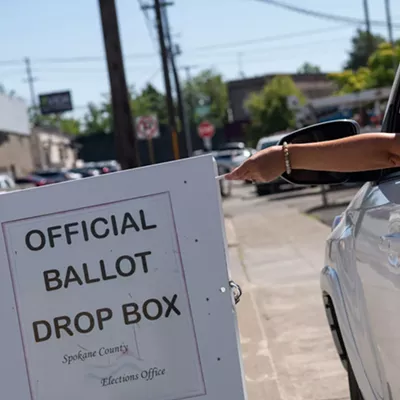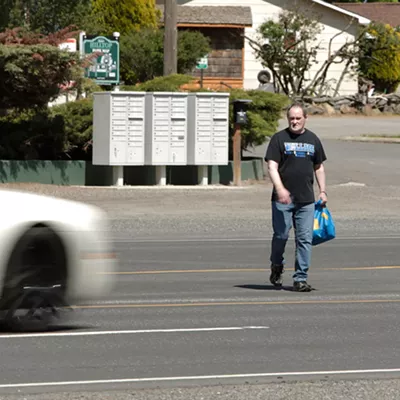On Monday, Stone acknowledged an appeal urging the city to reconsider its plans to cut down 23 threes scattered along south Bernard Street was hand-delivered to his office a week earlier. The trees are coming down during Bernard's repaving and reconstruction this summer -- part of the 2004 voter-approved street bond. Stone's week of silence alarmed appellants, who worried that cutting down the trees was imminent. They were given only the vaguest of dates for this -- and the most oft-repeated was Monday, April 24.
"Nothing will happen this week," Stone says. And further, "For any property involved in the appeal, no action will be taken on those trees until the appeal runs its course."
The appeal was signed by at least four of seven affected property owners, and joined by two citizen groups, two neighborhood councils and the Gonzaga Law Clinic. Appellants contend the city is wrongly calling the Bernard Street repaving (from 14th to 29th avenues) a "maintenance project" when really it's a "capital project."
It's fine print, certainly, but the devil is in the details.
Projects considered maintenance don't have to follow the guidelines of the city's comprehensive plan; capital projects do.
This is an important distinction for many of the residents.
Lorax-like & r & Their battle with city engineers over the scattering of street trees is not Spokane's version of Dr. Seuss' Lorax ("I speak for the trees!").
Yes, it looks like the Lorax at times. There have been candle-lit vigils on fog-shrouded winter evenings. This tree or that one has been carefully draped with yellow ribbons. People speak so fiercely about protecting the 23 trees and their value to society that one would think driving along Bernard was entering a hushed urban glade and that war and poverty have been conquered.
It's easy to eye-roll, but it's not about the trees entirely.
"In the bigger picture, at least to us, the city spent millions of dollars and thousands of hours crafting a comprehensive plan and adopting code based on that plan and said, 'We're going to use it.' And then ... they haven't," says John Covert, a state Department of Ecology staffer and president of Citizens for Sensible Transportation Planning, which has joined the appeal. "From our perspective, they are not following the spirit or the letter or the intent of the comp plan."
The city contends that the 2004 street bond projects are maintenance and don't involve the comp plan.
Covert is credited as the eagle-eye who caught the following sentence in the Spokane Municipal Code: "Public improvements through the investment of public capital funds, regardless of the source (emphasis added), are to conform to and implement the comprehensive plan."
To neighbors like Covert, the $117 million of taxpayer money used for street improvements should buy citizens a voice.
"Regardless of whether or not the Bernard Street trees survive, we want to see infrastructure there that would allow other canopy trees to be planted," he says, citing one of the priorities of the comp plan.
When Bernard was widened in the 1930s, Covert says the curbside planting strips were reduced to 18 inches. Ever since, the street trees have struggled -- and in fact their health and inadequate planting area is one of the reasons the city says they should come out. Instead of a cathedral-like canopy, Bernard's trees appear snaggle-toothed with one over here, three across the street and five more crowded together and down a block.
Removing the trees is especially ironic since the city's own data shows Bernard is traveled by slightly fewer cars today than it was three decades ago.
To Covert and others, addressing this situation is exactly what the comprehensive plan is for. People spent hours, he says, at the invitation of the city to discuss goals for street trees in a balance of commuter, pedestrian and neighborhood issues.
In order to hear the appeal, Stone must first revive a long-slumbering Urban Forestry Committee. There had been so little work for the committee in recent years that is has faded away. Four of the most-recent five members are willing to come back, Stone says.
The argument could eventually wind up in Superior Court.
Who Decides? & r & Richard Rush of the Cliff-Cannon Neighborhood Council recalls a similar flare-up several years ago when city engineers announced traffic safety work at 10th and Maple.
"They said they had a grant and would fix the intersection, and isn't it great for neighborhood?" Rush says. "So we say yeah it's great but are you also going to put in bike lanes like the comp plan requires?"
The staffers told the group they didn't have to follow the comp plan, Rush recalls, until the neighborhood council went to then-Mayor John Powers who ordered otherwise.
"It takes political leadership. Sadly the politicians we have today don't have the courage to stand up to their own engineering department and do things right," Rush says.
Indeed, and who speaks for the trees?
















